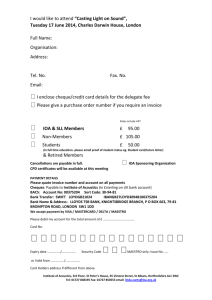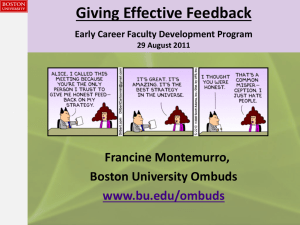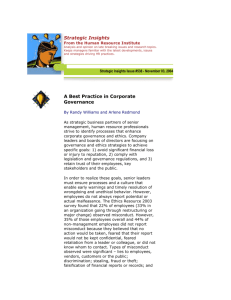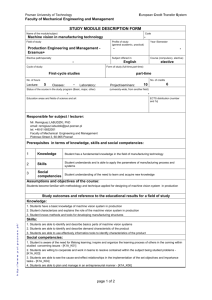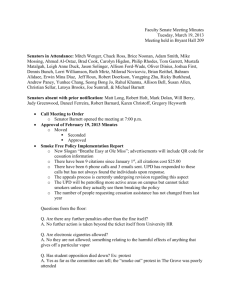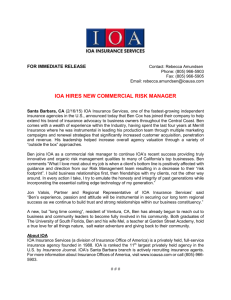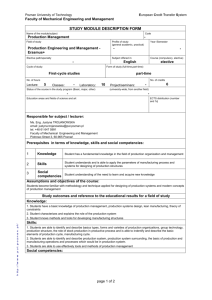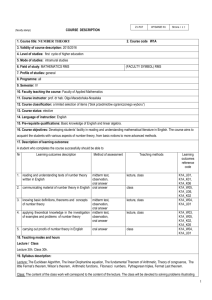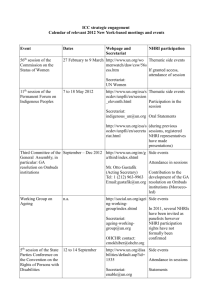Observations of an “Inside Outsider” on the Future and Challenges
advertisement
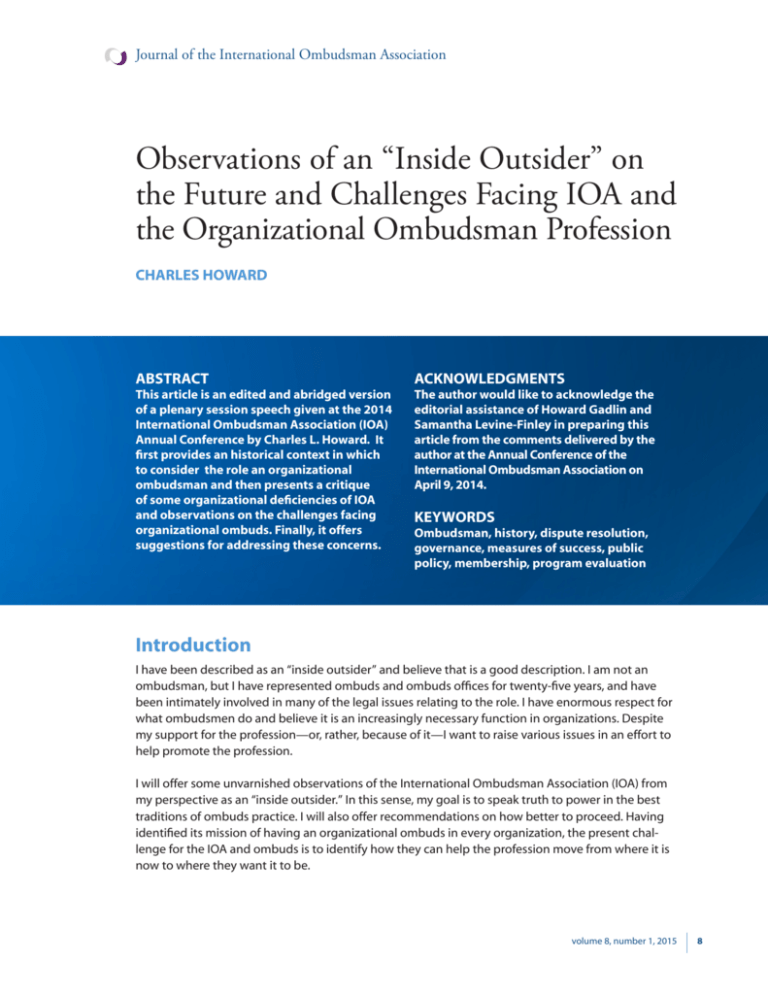
Journal of the International Ombudsman Association Observations of an “Inside Outsider” on the Future and Challenges Facing IOA and the Organizational Ombudsman Profession CHARLES HOWARD ABSTRACT ACKNOWLEDGMENTS This article is an edited and abridged version of a plenary session speech given at the 2014 International Ombudsman Association (IOA) Annual Conference by Charles L. Howard. It first provides an historical context in which to consider the role an organizational ombudsman and then presents a critique of some organizational deficiencies of IOA and observations on the challenges facing organizational ombuds. Finally, it offers suggestions for addressing these concerns. The author would like to acknowledge the editorial assistance of Howard Gadlin and Samantha Levine-Finley in preparing this article from the comments delivered by the author at the Annual Conference of the International Ombudsman Association on April 9, 2014. KEYWORDS Ombudsman, history, dispute resolution, governance, measures of success, public policy, membership, program evaluation Introduction I have been described as an “inside outsider” and believe that is a good description. I am not an ombudsman, but I have represented ombuds and ombuds offices for twenty-five years, and have been intimately involved in many of the legal issues relating to the role. I have enormous respect for what ombudsmen do and believe it is an increasingly necessary function in organizations. Despite my support for the profession—or, rather, because of it—I want to raise various issues in an effort to help promote the profession. I will offer some unvarnished observations of the International Ombudsman Association (IOA) from my perspective as an “inside outsider.” In this sense, my goal is to speak truth to power in the best traditions of ombuds practice. I will also offer recommendations on how better to proceed. Having identified its mission of having an organizational ombuds in every organization, the present challenge for the IOA and ombuds is to identify how they can help the profession move from where it is now to where they want it to be. volume 8, number 1, 2015 8 Journal of the International Ombudsman Association Charles Howard Historical Context To fully understand this role’s potential for major organizations, one must understand the historical context in which the ombuds profession has developed. By historical context, I am not referring just to the evolution of the ombuds role from its roots in Scandinavia. That history is familiar to almost all ombuds (Howard 2010). Rather, I want to focus on the ombuds role in organizations and on my understanding of how society has changed and the pressures that have been placed on organizations. Let’s begin a hundred years ago, during the Progressive Era in the United States, and consider what Theodore Roosevelt and the Progressives had to deal with: political corruption brought about by the influence of big money, abusive business practices toward workers and labor, and the extraordinary concentration of business power and monopolistic practices. There is an analogy today in each of these areas. Some of the reforms that came out of the Progressive Era in response to these concerns were the direct election of US senators, a federal income tax, progressive labor reform, and new antitrust laws. In addition, it was during that era that unions began to grow significantly and to serve as a counterbalance to the power of industrial organizations. But the high point of union membership in the United States was in 1954.1 Union membership has been declining ever since. Currently union membership in the private sector is only about 7 percent of the workforce.2 In fact, more than 25 percent of all workers are no longer full-time employees; they are part-time, contingent, or contract workers (Howard 2010, 99–100). This decline in union membership and increase in the percentage of workers who are not “full” employees has created an unbalanced relationship between organizations and workers. It is unlikely that unions in the United States will reemerge as a counterbalancing force against business or government or large organizations in the immediate future. In addition to the decline of unions, we are now experiencing an unprecedented role for multinational corporations. Based on data that is now slightly more than ten years old, approximately 80 percent of the world’s industrial output is produced by the 1,000 largest corporations in the world (Howard 2010, 105). Similarly, of the one hundred largest economies in the world surveyed in 2003, fifty-three were corporations—another indication of a significant concentration of business power (Howard 2010, 82–83). This concentration of economic power would surely be even greater today. In addition, most of these large corporations are also not only multinational but also multicultural organizations. There are similar trends in academic institutions. In the university context, a significant number of universities have populations of more than 25,000 students, and American colleges have an unprecedented global focus and numbers of international students (Howard 2010, 82–83, 102–04). These changes present large organizations with challenges that are exacerbated by the increasing use of technology. There also are other demographic changes, including more gender diversity in the workforce and in organizational leadership (Howard 2010, 92–93, 95–97). When we look at how our society has responded to these challenges, it has often been through law and regulation. For example, consider the Dodd-Frank legislation,3 Title VII,4 and the Sarbanes-Oxley Act of 2002.5 But I think, in many ways, law is a clumsy tool to deal with these issues, because it does not operate on the front line. Let’s take three examples. volume 8, number 1, 2015 9 Journal of the International Ombudsman Association Charles Howard First, in order to protect people from retaliation, the law has tended to create a cause of action for retaliation. Unfortunately, the law cannot really protect people from retaliation. It only gives a person a cause of action to bring a retaliation claim. If a person has been retaliated against, he or she has the right to bring a lawsuit to claim that they suffered retaliation because, for example, that person was a whistle-blower. But at this point, that person has already lost, because in our system of law, he or she has become the adversary and the whole force of the organization is pitted against him or her. Second, there are many whistle-blower laws in the United States offering bounties to a whistle-blower who prevails on his or her claim, but these laws are not responsive to the dilemma faced by real people when they are considering whether to become whistle-blowers. A person has to decide that he or she is going be a whistle-blower without clear assurance that the claim will succeed or that the government will make a recovery on which a bounty will be paid. Even if the government ultimately determines that the whistle-blower is entitled to a bounty, the whistle-blower won’t receive that bounty until several years down the road (Howard 2010, 147–57; Kesselheim et al. 2010). And what happens to these people in the meantime? It is often a very difficult time for them—personally, professionally, and financially—and most will never receive a bounty (Howard 2010). Third, although there is a plethora of governmental legislation and regulation in an attempt to protect whistle-blowers from retaliation, so much of what whistle-blowers experience—and what organizational ombuds must deal with in the workplace or other areas where they operate—is what I would call interactions that can be retaliatory but are “below the radar.” It is in this space that laws and regulations are particularly ineffective, and it is this space where we most need a solution to help people and organizations. There is a limit to how effective laws and regulation can be in addressing “below the radar” retaliation, which can be quite chilling to experience. So who is going be on the front line to deal with these issues? Who is going to deliver value to large organizations and the people in them, to provide assistance in the face of how the organizations have evolved globally, the economic pressure on them, and the limitations of laws and regulations? It does not suffice to say this is a role that unions previously played—a role that has expanded with the growth and complexity of society—but unions cannot fill the role today. I believe organizational ombudsmen are ideally suited to fill that role. ROLE OF THE ORGANIZATIONAL OMBUDSMAN In contemplating the function that can be served by filling this role, my goal is to challenge readers to think in larger terms. In particular, I urge readers to consider two other points that I think should be the essential characteristics of whatever mechanism is designed to fit in that space. The first is the concept of checks and balances, which was one of the most fundamental principles in the design of the US government. In our private entities, businesses, foundations, universities, or any other type of organization that has a linear, top-down decision making model, however, a similar concept of checks and balances is rare. These organizations operate based on a pyramidal structure, with management decisions made at the top. Yet, when an organization has 10,000 or 20,000 or 100,000-plus employees and workers, inevitably there will be organizational blockages, conflict, and misconduct. volume 8, number 1, 2015 10 Journal of the International Ombudsman Association Charles Howard There is no question of whether an organization’s systems will fail on occasion; it is only a question of when and where. And the key systems design question is: How does one surface issues that are blocked? How do we remove those blockages? That is where I think ombuds come in. We can’t have dual drivers of the enterprise, but we can have an information flow to the top outside of the standard channels—and a mechanism to help an organization know where blockages are and how to deal with issues that have gotten stuck, thereby preventing them from surfacing. My second observation is that there are many formal reporting structures as a result of pressures from the law, as well as legislative and regulatory requirements. Indeed, I think there are so many laws and regulations from so many levels of government and other sources that the average person, including a reasonably experienced lawyer like me, often does not know where to go to raise an issue or how to address a concern. In a multicultural/multinational world, we should be asking ourselves what the sources of organizational information are—and how someone accesses information without triggering all of the investigational machinery that might then be used against him or her. A confidential source of information is therefore crucial. In trying to answer these questions, my analysis suggests that modern large organizations need a mechanism that can help to provide checks and balances by serving as an informal and confidential source of information and advice on options for surfacing issues and concerns. In my opinion, that is where the organizational ombudsman comes in. I believe this is an important role and that, as a result, every major organization should have an organizational ombuds. Although this will be a challenging undertaking to make a reality, I believe that seeing the development of the role for ombuds in this historical context should inspire us all. Current Challenges Facing IOA SMALL SIZE My first observation is that IOA is too small. The organization has grown gradually and now has almost 800 members. The IOA puts on a great conference, but if the goal is ombuds ubiquity, this pace and approach will not get the profession where it wants to be quickly enough. In a 2011 survey of Fortune 1000 companies, following up on a 1997 survey, only 14 percent of those companies had ombuds (Stipanowich and Lamare 2014). That 14 percent included anything that called itself an ombuds program, whether or not it operated in accordance with the IOA Standards of Practice. That number also represents a 40 percent increase in the utilization of ombuds programs over 1997, when the corresponding number was 10 percent (Stipanowich and Lamare 2014). Nevertheless, even a 14 percent penetration level is not enough to serve as a launching point for where the profession wants to go. Although there is more widespread acceptance of the ombuds concept today in colleges and universities, the role is far from universal even in that setting. The small size of IOA means the organization does not have the money to accomplish its goals. For this reason, I would challenge IOA to think big: have a vision of where it can be and a belief that it can do something, even though the way is unclear. If IOA really does believe that an ombuds program is a function that should be in every major organization, IOA will need to become much bigger than it is today. OVERRELIANCE ON VOLUNTEERS I believe that IOA is too dependent on its members for volunteer help in almost every aspect of what it does. One could not find a more dedicated and capable group of people. For example, those who volume 8, number 1, 2015 11 Journal of the International Ombudsman Association Charles Howard have served as president of IOA have done so on essentially a full-time basis despite the fact that each one also had a very demanding day job. However, I have observed burnout in these leaders after a year or two in this dual role. I believe this burnout is unnecessary, because there should be a way to enable volunteers to serve as leaders without having it take all of their time. To do that, however, requires both staff and IOA volunteers to assist with follow-through on policy decisions, as well as retaining people with specialized knowledge or skills, such as lawyers or management consultants, so that not everything has to be accomplished solely through the use of volunteers. To move to the next level, where IOA can achieve its mission, IOA will require staff and specialized assistance from outside its member base. I applaud IOA’s current efforts to move in this direction, but this takes money, which reinforces my first point: IOA needs to have a larger footprint and thus a bigger revenue base to accomplish its mission. LEADERSHIP TURNOVER A related concern is turnover on the IOA’s board of directors. This suggests that there is not enough continuity for long-term policy decisions. IOA is experiencing a generational transition, and that is good. But it takes more than a year or two of board service to understand the role fully and to participate knowledgeably. More continuity in leadership—longer terms, with less demanding workloads that are focused more on policy, with staff assisting with implementation—would be helpful. INSULARITY IOA has been too insular and has not done enough outreach to organizations such as the American Bar Association, the National Association of College and University Attorneys, the Association of Corporate Counsel, and similar groups. Yet these are constituencies that have the power to help influence the creation of ombuds offices. Being too insular is problematic and impedes the IOA’s ability to accomplish its mission. IOA’s focus has been too internally focused, with much debate about who should be a member rather than how to get more members. This insular focus has been limiting. A related concern is that many ombuds are too insular within their organizations. Most ombuds have been asked repeatedly to do more with less and must still serve the visitors who call every day. Yet I think it’s important that ombuds consider how others in their organizations view them. It is often hard for others to know what ombuds do, because most of the time ombuds operate confidentially (or “from behind a curtain,” so to speak). So what ombuds do and how they do it is often not well understood by others in their organizations, and many ombuds have not found a good way to share the value of their role with others. Addressing this problem should be a high priority, because ombuds are largely powerless in their organizations. Having others understand and appreciate the role of organizational ombuds is critical to their long-term success. The ombuds function requires one to be independent and neutral, but at the same time, it raises the question of how ombuds get support when they need it themselves. I think ombuds need both external and internal support. Although ombuds need support from others in their organizations, they also need IOA to help protect their role and function, as well as supply them with information that they cannot get on their own. To combine these two concepts, IOA should be a source of information to organizational ombuds on how to foster greater buy-in from the senior leaders of their organizations. volume 8, number 1, 2015 12 Journal of the International Ombudsman Association Charles Howard PUBLIC POLICY AND DEFICIENCIES IN IOA’S DECISION-MAKING PROCESSES In my view, IOA’s apparent reluctance to engage with the larger world is related to—or perhaps a consequence of—an internal decision-making process that is ill-suited to the demands of the larger world. Of course, all of these observations are interrelated. With more members, staff support, and continuity, maybe this would not be the case. However, I believe that the current IOA decisionmaking process needs improvement. IOA members in general have fabulous ombuds skills, but those skills may not—and sometimes do not—translate into effective organizational decision making for IOA in the hurly-burly of public policy formulation. I believe that, in order to realize IOA’s vision (an ombuds in every major organization), the association will need to claim a place at the table in the larger public debate. That includes drafting legislation and formulating policy. Accordingly, IOA should find a better way to make decisions in the often fast-paced and imperfect world of public policy formulation that is unfamiliar to many ombuds. Not only will such an effort take time and money, it will require more flexible and responsive decision making. As many are aware, I was one of the people involved in efforts going back many years to draft legislation in Texas that would help protect ombudsman communications as privileged. It was a very disappointing experience because decisions needed to be made about how to respond to various situations, and sometimes we could not get decisions made in a timely fashion—not because of any bad motives or ill will on the part of anyone in IOA, but because people responsible for making those decisions were working in a context that required a decision-making style with which they were inexperienced and uncomfortable. My observation is that, when we were faced with what were, in my opinion, “sneak attacks” and untruths, the extended debate among IOA participants over how to respond resulted in missing the opportunity to respond altogether. Thus, I believe that if IOA is going to venture into the larger world of public policy, a better decision-making process will be necessary. LOW LEVEL OF IOA MEMBERSHIP BENEFITS IOA is not yet giving its members benefits that a professional association should offer. Specifically, the organization needs to improve its external support for its members. What does it do for its members that they can’t do for themselves? There is little time for solo ombuds and those in very small practice groups to consider or tackle the larger questions confronting the profession. As such, IOA should take the lead in dealing with issues that many of its members face but that individual members may be powerless to address. For example, IOA should be helping its members deal with the “Dear Colleague” letter from Catherine E. Lhamon, the assistant secretary for civil rights at the US Department of Education’s Office for Civil Rights.6 Because IOA did not take the lead in developing a response, everyone was left to his or her own devices. Many US college and university ombuds programs still do not have access to counsel, so they were forced to deal with internal lawyers at their institutions on this issue from a distinctly disadvantageous position. Where was the IOA white paper? Where was the engagement with the Office for Civil Rights? I’m not talking about having IOA members necessarily present their cases themselves. IOA needs to employ knowledgeable and professional help to develop strategy and respond in these situations. LITTLE SUPPORT FOR OMBUDSMAN OFFICES IOA should provide more external support to urge those who create ombuds offices to comply with best practices in setting up new programs. Many programs are created by people who are not familiar with what an organizational ombuds program is and who may want to accomplish some other purpose. Help in trying to get programs to conform to the more standard structures that support the core principles that IOA has articulated would make a great deal of sense. Those two volume 8, number 1, 2015 13 Journal of the International Ombudsman Association Charles Howard factors—ombuds’ powerlessness in their own organizations and the idiosyncratic nature of many of the programs—have increased the vulnerability of individual ombuds, which can lead to erosion and depreciation of even good ombuds programs over time. There are many reasons why this happens, some of which have nothing to do with whether or not an ombuds is doing a good job. For example, whenever there is a regime change in senior administration or senior management, an ombuds program is at risk. Ombuds should always remember that their role is not a source of revenue; it is an expense item. There is jealousy and competition from other functions that believe they should be able to do what ombuds do. In the face of this constant pressure and the failure of many ombuds to have internal protectors, it is hard for programs to resist the forces of erosion and devaluation. Addressing this issue will require both IOA and individual ombuds to develop ways to help others understand the value added by the ombuds office. LACK OF DATA AND THE ABILITY TO USE IT Ombuds often don’t understand how best to collect and present statistical data (aka “speak data”). Yet everyone to whom an ombuds reports—and the whole context in which most ombuds operate—is increasingly data driven. All of the people with whom ombuds interface look at data on every other function in the organization. Management of every kind, in every organization, is data driven. So when ombuds are presenting trend reports or annual reports, or communicating the return on investment in the ombuds office, ombuds need to be able to “speak data.” This means knowing how to collect and analyze data to support observations or conclusions that help to demonstrate the effectiveness of an ombuds program. An issue related to “speaking data” is the question of accountability. I do not know of any other function in any organization that is not subject to routine or periodic audits or reviews and then held accountable. And so my question is: How are ombuds held accountable? Collectively, the ombuds profession has not addressed this issue or developed recommendations for the audit, review, and assessment of ombuds offices. I think developing standards and practices under which third-party audits may occur will help to both improve practices and demonstrate greater credibility internally. Where We Go from Here In light of the sometimes-harsh observations I have made about IOA and individual ombuds practices, I would like to offer some suggestions about how both practitioners and IOA can move forward and achieve their strategic vision of an ombuds program in every major organization. Knowing where you want to go is not enough; there needs to be both planning and execution to achieve this goal. GROW MEMBERSHIP AND REVENUE It is crucial that IOA focus on growing membership and revenue. I would urge the association not to fight over who is a member or the types of membership categories. Having a “bigger tent” philosophy, working with partnerships, working with corporate sponsors, and finding models from other successful member-driven organizations can help IOA increase revenue. IMPROVE SUPPORT MECHANISMS AND RESTRUCTURE CERTIFICATION It is important that IOA find a way to provide more external support mechanisms for individual practices. One suggestion is to separate the certification of people from the certification or accreditation of programs. Evaluating ombuds for personal certification should be based on skills, knowledge, and experience. Accrediting programs should be based on whether a program complies with important volume 8, number 1, 2015 14 Journal of the International Ombudsman Association Charles Howard programmatic features. The goals of the larger profession will be better served by having an objective external program assessment that could bolster efforts by ombuds to align operations with the key principles that support the best practices of organizational ombuds. IMPROVE IOA GOVERNANCE IOA should consider revising its governance and decision-making process to create longer terms for board members, and to demand that they focus more on policy than operations. Having staff to help implement and follow through with decision making should result in a more manageable load for board members as well as less turnover. This will also help IOA expand its outreach efforts to both its members and the larger world. For members, IOA should be the support that helps ombuds do collectively what they cannot do for themselves individually. IOA’s development of standard reporting categories was exactly that sort of effort. I would urge IOA to hold more conferences, develop rebuttal packages for members to supply to their noncompliant organizations, create informational packages for companies that might consider an ombuds program, and distribute updates and “hot topic” bulletins to members. SUPPORT RESEARCH IOA and ombuds would benefit greatly from finding a collective way to sponsor research on many of the pressing issues facing the profession. A host of dispute-resolution programs at universities may welcome the chance to have topics for either master’s or doctoral dissertations. Sponsoring that sort of primary research or getting grants to sponsor that primary research could be very valuable. Linkages that could come out of these endeavors could also be important. In a similar vein, institutions of higher learning should be offering more education about ombuds. I am aware of a few university courses, but there are far too few of them. Every law school that prides itself on having a dispute-resolution program should be offering a course on ombuds. This is a missed opportunity in terms of outreach to the academic world. One of the topics most in need of additional research is the development of better ways to demonstrate the value that ombuds programs bring to organizations. This is a common challenge faced by all non-revenue-producing functions that help organizations avoid costs. Nevertheless, IOA needs to do more to gather data about how an organization’s ombuds program creates a measurable benefit, thereby allowing ombuds to provide the type of data analysis that many senior managers desire. Developing subject-matter linkages and outreach to other sectors is also important. For example, what is being done to reach out to the health-care world? Every major hospital or hospital network in the United States—and the world—is a prime target for an organizational ombuds program, and yet there is a great resistance in the health-care industry. So what is the strategic plan to address that sector? How do ombuds and IOA reach out to government? I think part of that outreach could involve assembling focus groups, including focus groups of senior executives. It might be helpful to have them tell us what they know—or what they think they need to know—and what would matter most to them about ombuds programs. Finding a way to be engaged with what happens in Washington, DC, also remains very important, as is engagement with what is happening around the world. Trying to address public policy from the perspective of the larger world is valuable. volume 8, number 1, 2015 15 Journal of the International Ombudsman Association Charles Howard ENGAGE IN PROGRAM EVALUATION The IOA must develop a mechanism for external validation of what ombuds do, in order to enhance ombuds’ credibility in their organizations and in the larger world. Without compromising confidentiality, routine evaluations would be helpful in providing senior leaders with data for benchmarking. Also, having a third-party audit-management letter, as is common with other types of audits, would help to identify ways to improve or issues to address. It is no longer realistic for the profession not to have a way to hold ombuds accountable for their work. PURSUE LEGAL SUPPORT Privilege cannot be the sole support for ombudsman confidentiality. Although I do not think that a claim of privilege should be overlooked where the law of the applicable jurisdiction and the facts can support it (meaning, the way in which a program has been established, documented, and operated), we should not overlook other bases on which to support a claim of confidentiality. There are ways to legally support a claim of confidentiality that may not be quite as strong or as allencompassing as recognition of a testimonial privilege, but which are easier to assert and more likely to receive judicial approval. For example, offices can include language (in charters, brochures, and elsewhere) explaining that users of the office will abide by the principles on which the program was based. Those principles would include not calling the ombuds to testify with respect to confidential communications. Likewise, it should be a priority for IOA to help ombuds obtain access to lawyers. Speaking of lawyers, it is clear that practitioners would benefit if more lawyers were knowledgeable and able to represent ombuds. The knowledge involved in representing this strange structure known as an organizational ombuds is quite nuanced and often requires a breadth of experience. Proactively educating counsel about ombuds work and ombuds legal issues is critical, as is enabling ombuds programs to obtain independent counsel to advise them. REVISIT THE IOA CODE OF ETHICS AND STANDARDS OF PRACTICE It may be time to revisit whether the IOA Code of Ethics and Standards of Practice still adequately serve IOA’s purposes today. A related inquiry should explore the interplay between the language used in these documents and other professional or ethical obligations that might apply to social workers, mental-health professionals, medical providers, attorneys, or other mandatory reporters on topics such as reporting incidents involving risk of harm to children or where there is an imminent threat of harm. Other professions have their own ethical guides and constraints. Understanding how those professions have dealt with these vexing issues could help IOA better evaluate its own principles and determine whether to revise them. For example, I have said before that one of the points I take issue with in the Standards of Practice is provision 3.1, which says an ombuds should not breach confidence except where there appears to be an imminent threat of serious harm and where there is no other reasonable option.7 I have long thought that the phrase “and where there is no other reasonable option” should be deleted, because it creates fertile ground for a factual discovery battle of what reasonable steps an ombuds did or should have taken that would invalidate any confidentiality. volume 8, number 1, 2015 16 Journal of the International Ombudsman Association Charles Howard Conclusion I remain an ardent supporter of IOA’s goal of ombuds ubiquity. I believe the institutions in our society need this function, and I’m willing to help IOA get there. IOA needs to get bigger and stronger in order to grow this profession because of the need for it in large organizations all over the world. This is true especially because the profession of an organizational ombuds is relatively new, and it is operating in uncharted waters with significant forces arrayed against it. IOA faces formidable challenges, but with an action plan based on where the association is and where it wants to be, I think the ombudsman profession can make great progress. volume 8, number 1, 2015 17 Journal of the International Ombudsman Association Charles Howard NOTES REFERENCES 1.Gerald Mayer, “Union Membership Trends in the United States,” Washington, DC: Congressional Research Service, August 31, 2004, http://digitalcommons. ilr.cornell.edu/cgi/viewcontent. cgi?article=1176&context=key_ workplace. Howard, Charles L. (2010). The Organizational Ombudsman: Origins, Roles and Operations—A Legal Guide. Washington, DC: American Bar Association. 2. Drew DeSilver, “American Unions Membership Declines as Public Support Fluctuates,” Fact Tank, Pew Research Center, February 20, 2014, http://www. pewresearch.org/fact-tank/2014/02/20/ for-american-unions-membership-trailsfar-behind-public-support). 3. Dodd-Frank Act, US Commodity Futures Trading Commission, accessed May 15, 2015, http://www.cftc.gov/ lawregulation/doddfrankact/index.htm. Kesselheim, Aaron S., David M. Studdert, and Michelle M. Mello. 2010. “Whistle-Blowers’ Experiences in Fraud Litigation against Pharmaceutical Companies.” New England Journal of Medicine 362:19. Stipanowich, Thomas J., and J. Ryan Lamare. 2014. “Living with ADR: Evolving Perceptions and Use of Mediation, Arbitration, and Conflict Management in Fortune 1000 Corporations.” Harvard Neg. L. Rev. 19 (Spring 2014): 60. 4, Title VII of the Civil Rights Act of 1964, US Equal Employment Opportunity Commission, accessed May 15, 2015, http://www.eeoc.gov/laws/statutes/ titlevii.cfm. 5. Public Law 107–204, US Securities and Exchange Commission, accessed May 15, 2015, http://www.sec.gov/about/laws/ soa2002.pdf. 6. Notice of Language Assistance: Dear Colleague Letter on Title IX Coordinators, US Department of Education Office for Civil Rights, last modified April 24, 2015, accessed May 15, 2015, http://www2. ed.gov/about/offices/list/ocr/letters/ colleague-201504-title-ix-coordinators. pdf. 7. IOA Standards of Practice, International Ombudsman Association, last modified October 2009, accessed May 15, 2015, http://ombudsassociation.org/IOA_ Main/media/SiteFiles/IOA_Standards_ of_Practice_Oct09.pdf. volume 8, number 1, 2015 18
